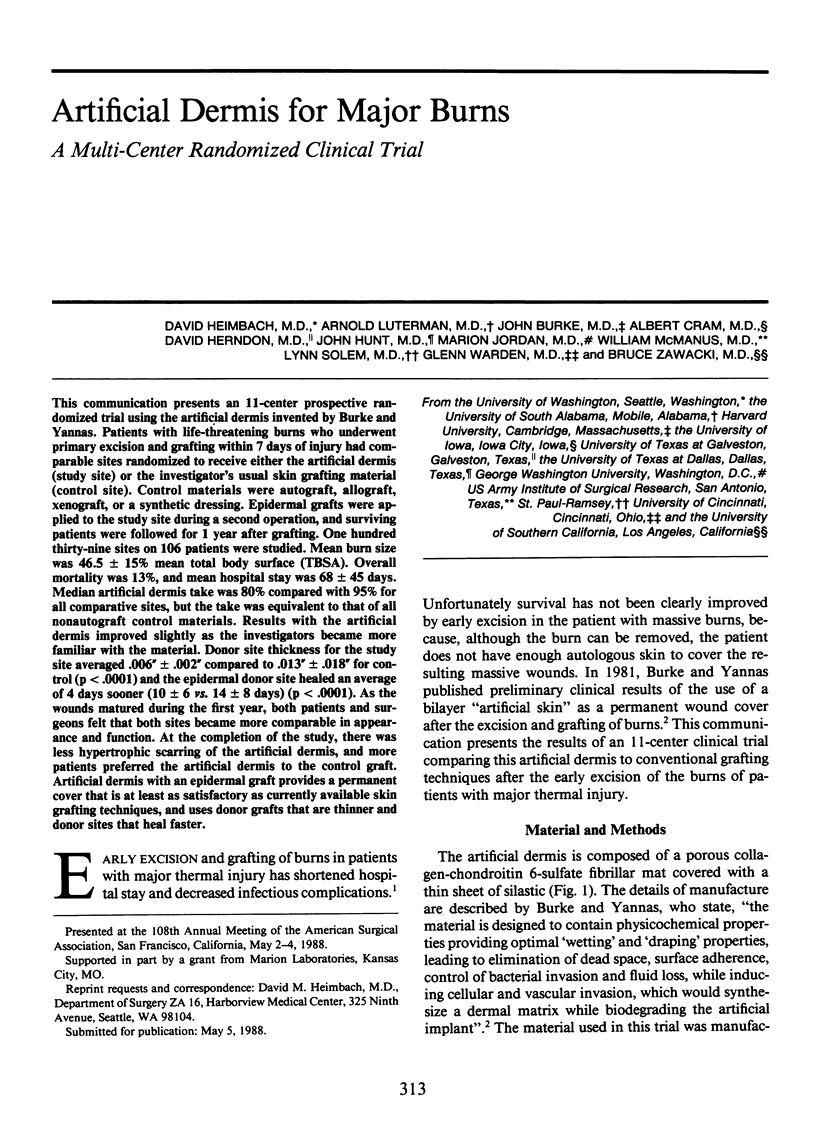Abstract
This communication presents an 11-center prospective randomized trial using the artificial dermis invented by Burke and Yannas. Patients with life-threatening burns who underwent primary excision and grafting within 7 days of injury had comparable sites randomized to receive either the artificial dermis (study site) or the investigator's usual skin grafting material (control site). Control materials were autograft, allograft, xenograft, or a synthetic dressing. Epidermal grafts were applied to the study site during a second operation, and surviving patients were followed for 1 year after grafting. One hundred thirty-nine sites on 106 patients were studied. Mean burn size was 46.5 +/- 15% mean total body surface (TBSA). Overall mortality was 13%, and mean hospital stay was 68 +/- 45 days. Median artificial dermis take was 80% compared with 95% for all comparative sites, but the take was equivalent to that of all nonautograft control materials. Results with the artificial dermis improved slightly as the investigators became more familiar with the material. Donor site thickness for the study site averaged .006'' +/- .002'' compared to .013'' +/- .018'' for control (p less than .0001) and the epidermal donor site healed an average of 4 days sooner (10 +/- 6 vs. 14 +/- 8 days) (p less than .0001). As the wounds matured during the first year, both patients and surgeons felt that both sites became more comparable in appearance and function. At the completion of the study, there was less hypertrophic scarring of the artificial dermis, and more patients preferred the artificial dermis to the control graft. Artificial dermis with an epidermal graft provides a permanent cover that is at least as satisfactory as currently available skin grafting techniques, and uses donor grafts that are thinner and donor sites that heal faster.
Full text
PDF






Images in this article
Selected References
These references are in PubMed. This may not be the complete list of references from this article.
- Achauer B. M., Hewitt C. W., Black K. S., Martinez S. E., Waxman K. S., Ott R. A., Furnas D. W. Long-term skin allograft survival after short-term cyclosporin treatment in a patient with massive burns. Lancet. 1986 Jan 4;1(8471):14–15. doi: 10.1016/s0140-6736(86)91896-9. [DOI] [PubMed] [Google Scholar]
- Alexander J. W., MacMillan B. G., Law E., Kittur D. S. Treatment of severe burns with widely meshed skin autograft and meshed skin allograft overlay. J Trauma. 1981 Jun;21(6):433–438. [PubMed] [Google Scholar]
- Black K. S., Hewitt C. W., Smelser S., Yearsley S., Bazzo D. E., Achauer B. M. Cyclosporine and skin allografts for the treatment of thermal injury. II. Development of an experimental massive third-degree burn model demonstrating extensive graft survival. Transplantation. 1988 Jan;45(1):13–16. doi: 10.1097/00007890-198801000-00004. [DOI] [PubMed] [Google Scholar]
- Burke J. F., Quinby W. C., Bondoc C. C., Cosimi A. B., Russell P. S., Szyfelbein S. K. Immunosuppression and temporary skin transplantation in the treatment of massive third degree burns. Ann Surg. 1975 Sep;182(3):183–197. doi: 10.1097/00000658-197509000-00002. [DOI] [PMC free article] [PubMed] [Google Scholar]
- Burke J. F., Yannas I. V., Quinby W. C., Jr, Bondoc C. C., Jung W. K. Successful use of a physiologically acceptable artificial skin in the treatment of extensive burn injury. Ann Surg. 1981 Oct;194(4):413–428. doi: 10.1097/00000658-198110000-00005. [DOI] [PMC free article] [PubMed] [Google Scholar]
- Davies J. W. Synthetic materials for covering burn wounds: progress towards perfection. Part I. Short term dressing materials. Burns Incl Therm Inj. 1983 Nov;10(2):94–103. doi: 10.1016/0305-4179(83)90005-0. [DOI] [PubMed] [Google Scholar]
- Davies J. W. Synthetic materials for covering burn wounds: progress towards perfection. Part II. Longer term substitutes for skin. Burns Incl Therm Inj. 1983 Nov;10(2):104–108. doi: 10.1016/0305-4179(83)90006-2. [DOI] [PubMed] [Google Scholar]
- Eldad A., Burt A., Clarke J. A., Gusterson B. Cultured epithelium as a skin substitute. Burns Incl Therm Inj. 1987 Jun;13(3):173–180. doi: 10.1016/0305-4179(87)90161-6. [DOI] [PubMed] [Google Scholar]
- Gallico G. G., 3rd, O'Connor N. E., Compton C. C., Kehinde O., Green H. Permanent coverage of large burn wounds with autologous cultured human epithelium. N Engl J Med. 1984 Aug 16;311(7):448–451. doi: 10.1056/NEJM198408163110706. [DOI] [PubMed] [Google Scholar]
- Gray D. T., Pine R. W., Harnar T. J., Marvin J. A., Engrav L. H., Heimbach D. M. Early surgical excision versus conventional therapy in patients with 20 to 40 percent burns. A comparative study. Am J Surg. 1982 Jul;144(1):76–80. doi: 10.1016/0002-9610(82)90605-5. [DOI] [PubMed] [Google Scholar]
- Heck E. L., Bergstresser P. R., Baxter C. R. Composite skin graft: frozen dermal allografts support the engraftment and expansion of autologous epidermis. J Trauma. 1985 Feb;25(2):106–112. [PubMed] [Google Scholar]
- Madden M. R., Finkelstein J. L., Staiano-Coico L., Goodwin C. W., Shires G. T., Nolan E. E., Hefton J. M. Grafting of cultured allogeneic epidermis on second- and third-degree burn wounds on 26 patients. J Trauma. 1986 Nov;26(11):955–962. doi: 10.1097/00005373-198611000-00001. [DOI] [PubMed] [Google Scholar]
- Purdue G. F., Hunt J. L., Gillespie R. W., Hansbrough J. F., Dominic W. J., Robson M. C., Smith D. J., MacMillan B. G., Waymac J. P., Herndon D. N. Biosynthetic skin substitute versus frozen human cadaver allograft for temporary coverage of excised burn wounds. J Trauma. 1987 Feb;27(2):155–157. doi: 10.1097/00005373-198702000-00010. [DOI] [PubMed] [Google Scholar]
- Zawacki B. E., Asch M. A technique for autografting very large burns from very limited donor sites. Surgery. 1973 Nov;74(5):774–777. [PubMed] [Google Scholar]
- Zhang M. L., Wang C. Y., Chang Z. D., Cao D. X., Han X. Microskin grafting. II. Clinical report. Burns Incl Therm Inj. 1986 Dec;12(8):544–548. doi: 10.1016/0305-4179(86)90003-3. [DOI] [PubMed] [Google Scholar]







